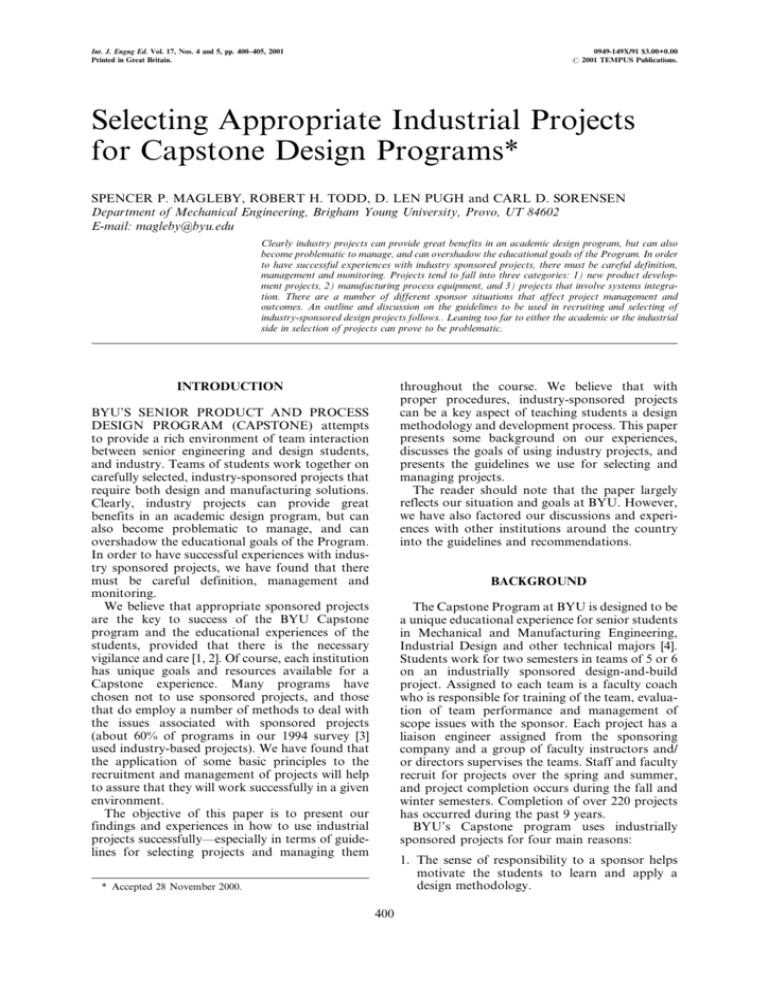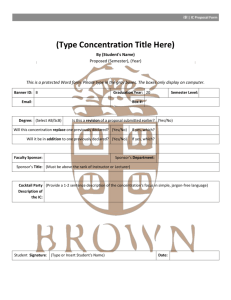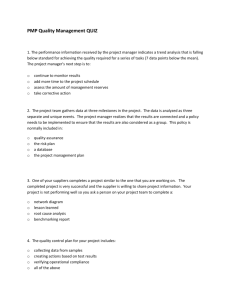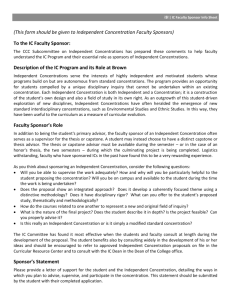Selecting Appropriate Industrial Projects for Capstone Design
advertisement

Int. J. Engng Ed. Vol. 17, Nos. 4 and 5, pp. 400±405, 2001 Printed in Great Britain. 0949-149X/91 $3.00+0.00 # 2001 TEMPUS Publications. Selecting Appropriate Industrial Projects for Capstone Design Programs* SPENCER P. MAGLEBY, ROBERT H. TODD, D. LEN PUGH and CARL D. SORENSEN Department of Mechanical Engineering, Brigham Young University, Provo, UT 84602 E-mail: magleby@byu.edu Clearly industry projects can provide great benefits in an academic design program, but can also become problematic to manage, and can overshadow the educational goals of the Program. In order to have successful experiences with industry sponsored projects, there must be careful definition, management and monitoring. Projects tend to fall into three categories: 1) new product development projects, 2) manufacturing process equipment, and 3) projects that involve systems integration. There are a number of different sponsor situations that affect project management and outcomes. An outline and discussion on the guidelines to be used in recruiting and selecting of industry-sponsored design projects follows.. Leaning too far to either the academic or the industrial side in selection of projects can prove to be problematic. throughout the course. We believe that with proper procedures, industry-sponsored projects can be a key aspect of teaching students a design methodology and development process. This paper presents some background on our experiences, discusses the goals of using industry projects, and presents the guidelines we use for selecting and managing projects. The reader should note that the paper largely reflects our situation and goals at BYU. However, we have also factored our discussions and experiences with other institutions around the country into the guidelines and recommendations. INTRODUCTION BYU'S SENIOR PRODUCT AND PROCESS DESIGN PROGRAM (CAPSTONE) attempts to provide a rich environment of team interaction between senior engineering and design students, and industry. Teams of students work together on carefully selected, industry-sponsored projects that require both design and manufacturing solutions. Clearly, industry projects can provide great benefits in an academic design program, but can also become problematic to manage, and can overshadow the educational goals of the Program. In order to have successful experiences with industry sponsored projects, we have found that there must be careful definition, management and monitoring. We believe that appropriate sponsored projects are the key to success of the BYU Capstone program and the educational experiences of the students, provided that there is the necessary vigilance and care [1, 2]. Of course, each institution has unique goals and resources available for a Capstone experience. Many programs have chosen not to use sponsored projects, and those that do employ a number of methods to deal with the issues associated with sponsored projects (about 60% of programs in our 1994 survey [3] used industry-based projects). We have found that the application of some basic principles to the recruitment and management of projects will help to assure that they will work successfully in a given environment. The objective of this paper is to present our findings and experiences in how to use industrial projects successfullyÐespecially in terms of guidelines for selecting projects and managing them BACKGROUND The Capstone Program at BYU is designed to be a unique educational experience for senior students in Mechanical and Manufacturing Engineering, Industrial Design and other technical majors [4]. Students work for two semesters in teams of 5 or 6 on an industrially sponsored design-and-build project. Assigned to each team is a faculty coach who is responsible for training of the team, evaluation of team performance and management of scope issues with the sponsor. Each project has a liaison engineer assigned from the sponsoring company and a group of faculty instructors and/ or directors supervises the teams. Staff and faculty recruit for projects over the spring and summer, and project completion occurs during the fall and winter semesters. Completion of over 220 projects has occurred during the past 9 years. BYU's Capstone program uses industrially sponsored projects for four main reasons: 1. The sense of responsibility to a sponsor helps motivate the students to learn and apply a design methodology. * Accepted 28 November 2000. 400 Selecting Appropriate Industrial Projects for Capstone Design Programs 401 Fig. 1. Engineering managers at Becton-Dickinson accept a plaque of appreciation for their sponsorship of a capstone project. 2. The pressure to complete a project that is larger than an individual student can handle motivates the team to learn about team processes and how to apply them. 3. Faculty has a practical way to keep in touch with industryÐby being involved as coaches to student teams charged with solving industrially relevant projects [3], and the faculty coaches must learn with the students. 4. Because the sponsor is outside the university, the faculty do not have all the answers. Students must learn to seek the voice of the customer to make the project successful. issues has occurred, including faculty loading (although full resolution of this is rare), faculty evaluation, coaching as teaching versus research, intellectual property ownership, intellectual property protection, product liability and indemnification, and contract agreements. For further detail on these issues see reference [5]. BYU recruits projects from all types of companies. Sponsors range from large corporations such as Boeing, General Motors, Texas Instruments, and Ford to small companies such as Bioxide, Burrows Marble and TransEra. We have also had individual entrepreneurs sponsor projects to develop ideas into products. The largest fraction of our projects comes from medium-sized companies such as Thiokol, Becton-Dickinson, and NMB Technologies. Faculty and staff members of the university carry out formal and informal visits to recruit sponsors using brochures and videos to explain the direct and indirect benefits of sponsoring the Capstone Program. Access to samples of the recruiting materials is available through the Capstone website (http:\\www.byu.edu/me/ capstone). Completion of over 200 sponsored projects has occurred in the past 8 years, with a sponsorship of over $3,000,000. An important aspect of fostering beneficial relationships involves recognizing the contribution of the sponsors (see Fig. 1). Many educational and administrative issues have arisen due to the use of industrially sponsored projects. Satisfactory resolution of most of these 1. New product development projects. 2. Manufacturing process equipment. 3. Projects that involve systems integration. TYPES OF PROJECTS We generally recruit projects that have tended to fall into three categories: For the purposes of BYU's Capstone program, we prefer the first two categories as they can be selfcontained (achieve closure) with fewer interactions out of our control. However, successful completion of systems integration projects is possible. We have worked with a number of different sponsor situations and different project types. Sponsor situations are important to us because different situations carry different amounts of risk to BYU, likelihood of payment, and expected fee structures. An explanation of sponsor situations for both internal and external projects follows: External sponsor situations . Normal Industrial: An industrial sponsor needs to address a problem that fits our objectives. This type of project is generally our highest priority, because there is little risk to BYU, either from liability or from failure to achieve a successful result on the project. The project sponsor is likely to be an engineering manager at 402 S. Magleby, R. Todd et al. Table 1. Summary of sponsor situations. The list includes the sponsoring individual and the liaison for each situation, along with the fee structure and likelihood of receiving payment, the perceived risk in terms of liability and problems if the project is not successful, and the priority of pursuing this project type at BYU. Sponsor Situation Sponsoring Individual Liaison Fee/Likelihood Risk Priority Normal Industrial Engineering Manager Engineer at sponsor company Full/High Low High Entrepreneur Technology Implementation Philanthropic The entrepreneur Company that is to benefit from technology BYU donor(s) none Engineer at sponsor co. Full/ Medium Full/Medium High Medium Low High Someone representing needs of group to benefit Materials & coaching Low Only one Internal BYU BYU Group Representative of the group Full or Partial/High Low ME high, others Low College Research Support Individual Researcher Researcher Full/High Medium Medium Fixed Contest ME Department and/or donor(s) none Materials & coaching Low Only one or two Technology Development Technology Transfer Office or Developer none Full/High Medium Medium the sponsoring company. The liaison is generally an engineer who reports to the project sponsor. . Entrepreneur: A person or small group wants a product developed or refined. Some of our best projects for content came from entrepreneurs. However, there is a substantial risk to BYU in accepting such a project. Entrepreneurs are unlikely to have the engineering resources to finish a project, so a project that gets 80% done is not very useful to the sponsor. Thus, there is a high risk that the sponsor will be unhappy. In addition, there is a relatively high risk that the sponsor will be unable to pay the sponsor fee as agreed. The entrepreneur generally serves as both the sponsor and the liaison. . Sponsored Technology Implementation: There is identification of a sponsor who may want to use some technology developed at BYU. The project implements the technology for the sponsor in some product or products. This type of project is desirable because of the latitude available to the team. However, there is a higher risk associated with this type of project than the normal industrial project, primarily because the sponsoring company is likely to be small. . Philanthropic: There is identification of a project that will bring benefit to a group that cannot afford to sponsor the project themselves. This kind of project is often outstanding from an educational perspective. However, it is difficult to find sponsors who are willing to pay the full fee for a project. This means that the University must absorb some of the costs of the project. Therefore, there is normally only one philanthropic project in a given year. Internal sponsor situations . Internal BYU Development: A group within BYU has requested the design and construction of a piece of equipment. The suitability of this kind of project varies widely, depending on the specifics of the situation. At their best, these projects are like normal industrial projects. At their worst, the sponsoring entity is unwilling to pay the project fee and clear identification of a customer has not occurred. The risk of these projects, however, is low. The reduced fees available make this situation clearly less preferable than a normal project. . College Research Support: There has been a request for the design and construction of a piece of equipment that will support the research of an individual or group in the College. The principal investigator for the research project sponsors the project and serves as liaison to the team. There is little risk due to liability, but the researcher is depending on using the results of the project to complete the research, so there is a moderate amount of risk due to potential failure. This type of project is lower priority than normal projects, but higher than other internal projects. . Design Contest: A team is to produce a product for a contest. The product and contest situation must match the educational objectives of the Capstone program. The risk due to this type of project is low, but the cost is high. Generally, there are no fees received for these projects. The department generally agrees to provide coaching at no cost, and the Capstone program agrees to pay a modest amount for materials. There is usually a limitation in the number of these projects in any given year to one or two. . Technology Development: A project used to bring technology that is in a fairly mature state within BYU to a commercial state. The BYU Technology Transfer Office generally sponsors this type of project. The risk is low. There is generally very little liaison support from the Selecting Appropriate Industrial Projects for Capstone Design Programs sponsor, which reduces the educational value of the project. Each different project and sponsor type has implications. A proper match of educational objectives and projects can lead to a successful experience. We believe that achieving the proper mix of projects and sponsors is important, although it is difficult. Pros and cons of industrially-sponsored projects Industrially sponsored projects take resources to recruit and manage. It is important that the administration of the University be supportive of the effort associated with this type of educational activity. There must be a careful review of the pros and cons of sponsored projects, in the context of the desired educational objectives early in the development of a program. We have identified the following pros and cons to employing industrially sponsored projects as important to consider with administrative officials to ensure justification of the additional resources. Pros: . . . . . . . . . . Provides student motivation Creates an industrial-like environment Real customer Realistic problems (open-ended) On-going industrial relations Potential for the sponsor to contribute funding for the projects Assists in placement of students Students can build confidence through success with a non-academic sponsor Faculty can stay relevant Faculty can observe the performance of the students in a `real life' situation Cons: . Consequences of failure are greater and real . Some faculty do not wish to work outside of their area or act in a coaching role . Additional need for faculty training and guidance [6] . Fabrication resources are difficult to predict . Liability and intellectual property issues must be carefully watched . Administrative procedures must be developed and managed . Effort in recruiting PROJECT SELECTION GUIDELINES We generally try to select and scope projects that will produce the best educational outcomes as described above. Several other institutions have established criteria for selecting projects. A recent example from Marin et al. can be found in reference [7]. Rather than using our selection criteria to eliminate projects, we generally prefer 403 to use the criteria proposed by potential sponsors to help focus the project. With most sponsors, we are able to identify a suitable project after some negotiation. At BYU we use the following guidelines in recruiting and selecting of industry-sponsored design projects: 1. The project should respond to, and solve where possible, a specific need for the company. There must be sufficient interest in the project for the sponsoring company to be willing to work with student teams. 2. Although the project must meet a need, it should generally not be on the critical path of a company. Mid or backburner projects are ideal. This can present a problem with small companies or entrepreneurs, as every project is critical. 3. The company must be willing to assign an engineer or designer who will dedicate some time to function as a liaison person for the project. This liaison must have a vested interest in the success of the project, and not feel intimidated by working with the university. 4. The project should involve both design and fabrication. It is difficult to test and prove the results without fabricating anything. 5. The scope of the project in terms of development time and fabrication resources required must be within the means of the university. 6. Projects should be of a design nature, and not the development of new technology. Research projects are hard to manage and predict, and require too much subject expertise. 7. There must be careful consideration of the ability of the sponsor to absorb and understand the results of the project. For small companies, or those without an engineering staff, it is difficult for the company to follow through with the completion of the project, particularly if the team has faltered in some way. 8. The sponsor must be willing to give the team some room to develop specifications and consider alternative solutions. If the team feels as of they are just workers for the liaison, there will not be sufficient motivation to learn. 9. Intellectual property issues can cause big headaches. Projects that involve extensive need to disclose proprietary information can lead to misunderstandings. CONCLUSIONS In order to serve an appropriate educational role in a Capstone course, and at the same time provide value to industry, there must be careful choice and management of sponsored projects. Leaning too far to either the academic or the industrial side can prove to be problematic. Our experience has shown that it is possible to achieve a balance that can greatly benefit both sides. 404 S. Magleby, R. Todd et al. To achieve that balance, there are some key criteria to meet in project and sponsor selection. After meeting the initial criteria, there must be constant management of the project scope, and maintenance of communication with the project sponsor. A key factor in overall success is a good match between the project coach, sponsor liaison and expected outcome of the project itself. REFERENCES 1. Spencer Magleby, Robert Todd and Carl Sorensen, Fostering an educational environment for integrated product and manufacturing process design, Proceedings of the International Conference on Education in Manufacturing, Society of Manufacturing Engineers, March 1996, San Diego, CA. 2. Robert Todd, Carl Sorensen and Spencer Magleby, Designing a Senior Capstone Course to Satisfy Industrial Customers, Journal of Engineering Education, 82(2), April 1993, pp. 92±100. 3. Robert Todd, Spencer Magleby, Carl Sorensen, Bret Swan, and David Anthony, A survey of capstone engineering courses in North America, Journal of Engineering Education, April 1995, pp. 165±174. 4. Carl Sorensen, Robert Todd, Spencer Magleby, and Alan Parkinson, Re-engineering design education: design process and learning activities, Proceedings of the ASME Design Engineering Technical Conferences, Design Methodology Division, Minneapolis, MN, September 1994. 5. Carl D. Sorensen and Robert Todd, Industry and academia working together to improve manufacturing education, Proceedings of the International Conference on Manufacturing Education for Excellence in the Global Economy, Society of Manufacturing Engineers, San Diego, CA, Oct 1998, p. 404. 6. Doroth G. Taylor, Spencer P, Magleby, Robert H. Todd, and Alan R. Parkinson, Training Faculty to Coach Capstone Design Teams, International Journal of Engineering Education, Vol. 17, No. 4. 7. John Marin, James E. Armstrong and James L. Kays, Elements of an optimal capstone design experience, Journal of Engineering Education, January 1999, pp. 19±22. Spencer P. Magleby is an Associate Professor in the Mechanical Engineering Department and Director of the Capstone Program at Brigham Young University. He came to BYU in 1989, after six years in the Aircraft Industry. His work there involved development of tools for advanced aircraft design and manufacture, concurrent engineering methods, and interdisciplinary design teams. Dr. Magleby received his PhD from the University of Wisconsin where his research centered on design. He has pursued research in design tools, team formation, team management and design processes. Dr. Magleby teaches design at the graduate and undergraduate level, and is interested in educational partnerships with industry. He has helped oversee over 220 design projects through his involvement with Capstone and graduate programs. Robert H. Todd is a Professor in the Mechanical Engineering Department at Brigham Young University. After ten years of industrial experience with both the General Motors Corporation and the Michelin Tire Corporation in Europe and North America in technical and senior management positions, he returned to academia. Dr. Todd received his Ph.D. degree from Stanford University in Mechanical Engineering Design, his MS degree from Stanford in Engineering Mechanics. At BYU Dr. Todd led a team of faculty from different disciplines to develop BYU's Capstone program and served as its founding director from 1990 until 1996. His research work involves developing instructional activities that help bridge the gap between industry and academia, improving the relevancy of engineering education, manufacturing process and machine design and development, water-jet cutting applications and design methods. Dr. Todd has been the author or co-author of over 30 research articles, two books and over 200 presentations to industry, government, and academia since coming to BYU in 1989. Len Pugh joined BYU as the Capstone Program's manager after twenty years of professional senior level management experience in a high-tech manufacturing environment. He is responsible for sponsor relationships and project recruiting organization. His diverse background includes management of test and product engineering groups with respect o marketing, market research, quality assurance, new product development, and customer service. He has extensive experience in project management, contract negotiations, development of departmental objectives and programs to meet stated objectives. He holds a Masters in Business Administration from the University of Utah and a Bachelors of Engineering Science, Electrical Engineering from Brigham Young University. Carl Sorensen is an Associate Professor in the Department of Mechanical Engineering. Dr. Sorensen received a Ph.D. from the Massachusetts Institute of Technology for arc Selecting Appropriate Industrial Projects for Capstone Design Programs welding process instrumentation. Following graduation, he served as a postdoctoral associate at MIT for two years working on improved instrumentation and modeling of resistance spot welding processes. At BYU, Dr. Sorensen has been active in experimental work and engineering design. He has written about 40 technical papers, and has consulted for a number of companies. He helped develop the Capstone Design Program at BYU, which has been responsible for completing nearly 200 projects for state, regional, and national companies. The sponsoring company implemented most of the 10 projects coached by Dr. Sorensen by and this resulted in additional projects. 405








